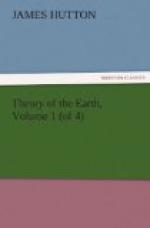Let us now take the map of Scotland, in order to observe the mixture of those two different species of countries, whereof the one is generally low and flat, the other high and mountainous; the one more or less provided with fossil coal, the other not.
From St Abb’s Head, on the east of Scotland, to the Mull of Galloway, on the west, there runs a ridge of mountains of granite, quartz, and schistus strata, which contain not coal. On each side of this ridge we find coal countries; Northumberland, on the one side, and, on the other, the shires of Ayr, Lanark, and the Lothians; the one is a mountainous country, the others are comparatively low or flat countries. Let us now draw another alpine line from Buchan and Caithness, upon the east, to the island of Jura, on the west; this traverses a mountainous country destitute of coal, and, so far as I know, of any marks of marine bodies. But, on each side of this great alpine ridge, we find the hard country skirted with one which is lower, flatter, or of a softer nature, in which coal is found, upon the one side, in the shires of Fife, Clackmannan, and Stirling; and, on the other, in that hollow which runs from the Murray Frith south-west, in a straight line, directed upon the end of Mull, and composed, for the most part, of water very little above the level of the sea. Here, to be sure, the coal is scarce, or not so evident; but there is coal upon the sea coast in several places of this great Bay betwixt Buchan and Caithness; and the lowness of the country, across this part of the island, is almost sufficient testimony that it had been composed of softer materials.
Thus the coal country of Scotland may be considered as in one band across the island, and included in the counties of Ayr, Lanark, and all those which border upon the Frith of Forth. Now, in all this tract of coal and tender strata, we do not find ridges of alpine stone or primary mountains, but we find many hills of solid rock, little mountains, from 500 to 1000 feet high; such as that beautiful conical hill North Berwick Law, Torpender Law, Arthur’s Seat, the Lowmands, and others of inferior note. That is to say, the whole of this included space, both sea and land, has been invaded from below with melted masses of whin-stone, breaking up through the natural strata of the country, and variously embossing the surface of the earth at present, when all the softer materials, with which those subterranean lavas had been covered, are washed away or removed from those summits of the country. Hence there is scarcely a considerable tubercle, with which this country also abounds, that may not be found containing a mass of whin-stone as a nucleus.
But besides those insulated masses of whinstone that form a gradation from a mountain to a single rock, such, for example, as that on which the Castle of Edinburgh is built, we find immense quantities of the same basaltic rock interjected among the natural strata, always breaking and disordering them, but often apparently following their directions for a considerable space with some regularity. We also find dykes of the same substance bisecting the strata like perpendicular veins of rock; and, in some places, we see the connection of these rocks of the same substance, which thus appear to be placed in such a different form in relation to the strata.




